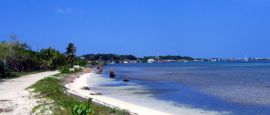If heritage and history are your thing, you’ll love Comayagua. The first capital of Honduras is a masterpiece of Spanish colonial architecture: cobbled streets, tiny plazas, whitewashed houses and grand churches, all of which frankly upstage rather tatty Tegucigalpa. The best time to visit is during the unique and fervent celebrations of Easter week (Semana Santa).
Honduras things to see and do
Tourist offices
Address: Colonia San Carlos, Edificio Europa, Tegucigalpa, CP 3261, Honduras
Tel: (504) 222 2124 ext. 502 or 503.
Opening Hours: Mon-Fri 0800-1700
www.letsgohonduras.com
The ancient city of Copán is one of the wonders of the Maya world, a major testament to this advanced culture, most notable for its intricately carved stelae. Highlights of the ruins include the magnificent Acropolis, the Great Plaza, and the Court of the Hieroglyphic Stairway. Base yourself in the charming nearby town of Copán, with its cobbled streets and excellent hotels and restaurants.
This vast and untamed wilderness is characterised by tropical forests, swamps, rivers and mangroves, and is one of the premier ecotourism destinations in the Americas. At its heart is the Rio Plátano Biosphere Reserve, a UNESCO World Heritage Site teeming with wildlife. Jump aboard a motorised dugout canoe and embark on a safari, staying in a straw-roofed hut in a riverside indigenous village.
Try canopy touring: a series of cables are fixed from tree to tree and, attached to a pulley while wearing a harness, you can 'fly' through the rainforest’s canopy. Honduras’ abundance of thick rainforests and jungles provide ideal opportunities for thrill-seeking canopy tours, with numerous circuits on the Bay Islands, Copán and Sambo Creek, on the north coast near La Ceiba.
Honduras’ wildlife refuges and national parks offer an exciting, unspoiled landscape, a multitude of flora and fauna, and huge biodiversity including rare mammals such as jaguars, pumas, ocelots, anteaters and tapirs. Tropical and pine forests, mountains, coastal wetlands and huge rivers create a wonderful opportunity for eco-tourism, with high-quality accommodation and expert local guides.
Honduras’ largest freshwater lake is a magnet for hundreds of species of birds and considered the country’s premier birding destination. Flanked by the highway between Tegucigalpa and San Pedro Sula, the lake is surrounded by coffee plantations, hot springs, caves and waterfalls; and there are plenty of hiking and fishing opportunities along its shores. Lakeside restaurants also serve up some of the tastiest fish dishes in the region.
Take advantage of the excellent hiking on offer in Pico Bonito National Park, near La Ceiba on the north coast. It offers dense green jungle, steep mountainsides, sparkling waterfalls and world-class birding. Pico Bonito itself is a challenging, climb, but there are plenty of gentler hikes through the vast park.
Nature guides lead boat tours along the winding canals of the Cuero y Salado Wildlife Refuge on the edge of the Pico Bonito National Park, which provides a wildlife habitat for monkeys, alligators and manatees, and some 200 species of birds. Drift through these vast wetlands that lead all the way to the Caribbean Sea and don’t forget your binoculars.
Play at being a pirate in Trujillo on Honduras' gorgeous Caribbean coast. Once a thriving port and a former capital of colonial Honduras, Trujillo is today home to many old Spanish buildings, a fascinating pirate history and superb tropical beaches. Nearby are several traditional Garifuna villages and the city is surrounded by national parks.
The crystalline waters and pristine coral reefs of the Bay Islands provide some of Central America’s best dive sites. The islands are one of the world's top destinations for learning to dive, with warm, calm waters and high quality, reasonably priced dive centres. And if you already have your PADI certificate, you can also take courses in underwater photography, cave diving and instructor training.
The exotic archipelago of the English-speaking Bay Islands is famed as one of the world’s premier diving destinations and home to some of Honduras’ top beach resorts. Hilly, tropical Guanaja and Roatán are protected by a great coral reef. Backpackers’ favourite Utila has sandy beaches ringed by tiny cays shaded by palm trees. There are several smaller islands worth visiting, including the Cayos Cochinos.
The Bay Islands are considered one of the best locations to spot the world’s largest fish, the whale shark. Measuring up to 10m (33ft) in length, these gentle, plankton-eating creatures glide through the waters and it is possible to slip gently into the water and swim alongside them. The Utila Whale Shark and Oceanic Research Centre runs excursions all year round, with the highest numbers seen in March and April.
Experience some of Central America's best white-water rafting along the Cangrejal River, near La Ceiba. The steep terrain of the Pico Bonito National Park creates raging rivers and waterfalls, the most spectacular of which is the Cangrejal. Several outfits offer jungle lodges and rafting experiences outside of rainy season, with the wettest months from August to December.
Admire the view across Tegucigalpa, the temperate capital city, from the site of its Christ of the Picacho monument, set atop the eponymous mountain to the north. Be sure to take a look around the city itself too; it has a certain rough-edged charm, especially the old historical centre with its colonial buildings and winding stone streets.
Also known as the ‘Caves of the Glowing Skulls’, because of the sparkling reflection off the human bones found here, these caves in the northeast near Catacamas are a spelunker’s paradise. The caves have been used by various ethnic groups since pre-Colombian times and are rich in Maya archaeology. Hire a guide as they are well hidden but worth seeking out.
Do you have any Feedback about this page?
© 2025 Columbus Travel Media Ltd. All rights reserved. No part of this site may be reproduced without our written permission, click here for information on Columbus Content Solutions.








 You know where
You know where